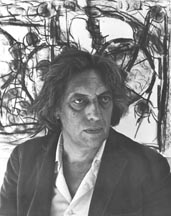
Jean-Paul Riopelle, born in Montreal, Quebec, in 1923, was destined to leave a significant mark on the world of art. As the only son of an architectural designer, Riopelle was exposed to creativity from an early age. His father, recognizing his artistic potential, arranged for him to study under Montreal artist Henri Bisson. Starting at the tender age of six, Riopelle spent his Saturdays with Bisson, learning traditional painting techniques. For a decade, he honed his skills, painting landscapes, still lifes, and figures, often accompanied by the melodies of the New York Metropolitan Opera playing in the background.
Despite his early training in traditional art, Riopelle's artistic journey took a dramatic turn when he began exploring abstract expressionism. This shift was foreshadowed by an experience in the summer of 1938 in the Gaspé region, where he painted scenes inspired by nature. As he observed his work, he noticed that his attempts to render natural elements like sea shells, sand, and water had resulted in abstract forms. This was his first encounter with abstraction, a style that would later define his career.
By the time he was 17, Riopelle was already experimenting with abstract art alongside his traditional work. However, his path to becoming a painter was not straightforward. Like many young Canadians, Riopelle harbored dreams of becoming a professional hockey player, and he even considered a career as a mechanic due to his aptitude for the trade. His father, on the other hand, hoped Riopelle would become an engineer, recognizing his talent in mathematics.
Riopelle initially followed his father's wishes, attending Polytechnique as a preliminary step toward engineering studies. However, his passion for art ultimately prevailed, leading him to enroll full-time at the École des Beaux-Arts in 1942, where he studied until 1945. During his time at the École des Beaux-Arts, Riopelle became deeply influenced by the works of Vincent van Gogh, whose bold use of color and expressive style left a lasting impression on him. He also admired the works of Renoir and Tintoretto, further shaping his artistic development.
For further studies, Riopelle attended L'École du Meuble from 1943 to 1944, where he came under the influence of Paul-Émile Borduas, a key figure in the Canadian avant-garde movement. Borduas, inspired by the French surrealist poet André Breton, was exploring free thought and spontaneous art, rejecting the traditional standards imposed by society. Under Borduas' guidance, Riopelle and his fellow students, including Marcel Barbeau, Roger Fauteux, and Fernand Leduc, among others, formed a group known as Les Automatistes.
The Automatistes were known for their explorations in automatic writing, drawing, and painting, where they sought to express the subconscious mind. Riopelle shared a workshop on University Avenue in Montreal with Marcel Barbeau and surrealist poet Rémi-Paul Forgues, where they delved into these experimental techniques. The group gained recognition for their innovative approach, and in 1946, Riopelle participated in the International Exhibition of Surrealists in New York City, where he and his fellow Montreal artists encountered American action painting, a movement that would greatly influence their work.

Riopelle's career took a significant turn when he moved to Paris, where he decided to live and work. In 1948, he married Françoise L'Espérance in Montreal, and the couple returned to Paris. That same year, Riopelle became a signatory to Borduas' Refus Global, a manifesto that rejected the traditional values of Quebec society and called for artistic and intellectual freedom.
In Paris, Riopelle's career began to gain momentum. A pivotal moment came when a sculptor friend invited him to display his paintings on the bare walls of her solo exhibition. On the opening day, a dealer purchased all of Riopelle's paintings and offered him a studio to work in. This marked the beginning of Riopelle's rise to prominence in the art world.
Throughout his career, Riopelle's style evolved, moving from the wild, sweeping brushstrokes of his early years to more controlled techniques. In the mid-1950s, he began using a palette knife to flatten out blobs of paint, creating a mosaic of flat color areas that became characteristic of his work. This technique, combined with his use of zig-zag lines and solid forms, distinguished his paintings and brought him international acclaim.
By the 1960s, Riopelle was producing around 200 canvases a year, a testament to his prolific output. His works were exhibited in prestigious galleries and museums worldwide, including the Tate Gallery in London, the Museum of Modern Art in New York, and the Musée d'Art Moderne in Paris. Riopelle's success also afforded him the freedom to pursue his passions outside of painting, including collecting sports cars, sailing, and flying.
Riopelle's contributions to the art world were widely recognized, earning him numerous awards and honors. In 1969, he was appointed a Companion of the Order of Canada, and in 1981, he received the Paul-Émile Borduas Prize from the Province of Quebec. Despite his international fame, Riopelle remained deeply connected to his Canadian roots, drawing inspiration from the landscapes and nature of his homeland.
Jean-Paul Riopelle's legacy as one of Canada's most celebrated artists endures, with his works continuing to captivate audiences around the world. His journey from a young student in Montreal to a master of abstract expressionism is a testament to his relentless pursuit of artistic innovation and his enduring influence on the global art scene.
Browse our collection of Canadian paintings for sale at the Canadian Classic Fine Art gallery, The best place to buy a painting online. We provide free shipping anywhere in Canada and the United States. Our Montreal art gallery sells paintings online exclusively and have a 14 days return policy.
